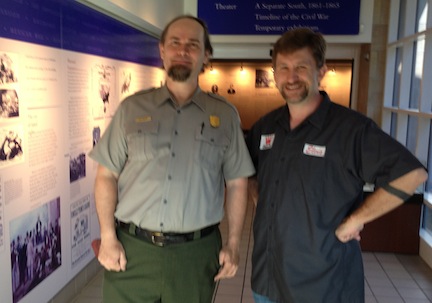An Interview with “Bushwhacking” author Lee White

With the dust now settled from last month’s sesquicentennial anniversary of the battle of Chickamauga, historian Lee White had the time to sit down with Emerging Civil War to talk about his new book on the battle, Bushwhacking on a Grand Scale.
Why was there a need for a new Chickamauga book?
For a battle of its size and scope, very little has been done on Chickamauga, and what has been done is either very general or very detailed in nature. I sought to produce something in the middle, something that could serve as a first book on the battle for a general audience, yet could provide new insights for a veteran student of the battle.
Do you think the battle of Chickamauga gets overshadowed in the larger story of the war in favor of some of the Eastern Battles?
Yes, like most of the battles in the Western Theater. That has always struck me as rather ironic, too, given the presence of Longstreet’s Corps and the large following some of his units have, like Hood’s Texas Brigade. The casualties alone at Chickamauga should have given it larger attention than it has received over the years. [More than 34,000 killed, wounded, and missing—more than 16,000 Federals and more than 18,000 Confederates.]
What are some of the features of your book that readers will enjoy?
I think readers will enjoy many of the soldier accounts that I have included, some of which have never been used in a history of the battle before. Chickamauga is known as “a soldiers’ battle,” and I have tried to bring their story to the forefront in this. I also think the story of the civilians is very compelling. Civilians seem to always be the unsung victims of the battle, and I think presenting their stories is very important as well.
You have a very personal connection to the battlefield (you were born on it). Can you tell us a little bit about your connection to the place?
The hospital I was born in sits on the very northern edge of the historic battlefield, a position once held by Col. Dan McCook’s Brigade against Bedford Forrest’s Cavalry on September 20. Over the years, the battlefield continued to play a role in my life. My parents brought me out there for Sunday outings and, when I was older, to see living history programs, etc. I was also impacted by just riding through the park in the back of the family car, looking at the monuments and cannons. I was, in many ways, the boy that William Faulkner alluded to in his famous reference about Gettysburg, and thirst for history was ingrained in me at an early age.
What most interested you in writing about this topic?
To address many things that I think have been left out of most narratives of the battle, to present stories that I think are very compelling, and also to give insights that I have formed about the battle to a wider audience than I have reached on my battlefield tours.
What was the most difficult aspect of writing this book?
For me the most difficult part was telling the story in such a short form. I have amassed a huge collection of accounts from period newspapers, archives, and the internet, and it was very hard to chose which stories to present. I was also worried that I was going to leave out something major. That worry led to many careful reviews and overviews of the text!
How did you conduct your research?
I’m always researching the battle, always looking for new stories to tell. Some of the ones presented in the book literally surfaced as I was writing the book.
There are a number of myths associated with Chickamauga. Tell us a little more about that.
Like most battles, Chickamauga has its fair share of myths and treasured legends. However, we have several that seem to always make it into most accounts that have been written on the battle. One of the biggest is the story of “The Gap” in the Union center and how it supposedly impacted the rest of the battle. Another focuses on the role that Bedford Forrest played in the battle, which was actually minimal and rife with problems. That did not benefit the Confederates.
You profile a number of little-known participants. Do you have a favorite? Can you tell us about him?
It’s very hard to pick a favorite, but I will say that its probably the story of Color Sgt. Jacob Lair of the 75th Indiana Infantry, who performed an act of gallantry that was worthy of a Medal of Honor during the largely forgotten fighting on September 19th. [After the regimental color-bearer was shot down, Lair rescued the unit’s colors and tried to rescue the unfortunate corporal, although the corporal was mortally wounded as Lair carried him from the field.]
Do you have plans for other projects now that this one is wrapped up?
Yes, I’m working on an entry in the wonderful map series that Savas Beatie is publishing. Mine focuses on Hood’s Tennessee Campaign. After that, I have several ideas that I would like to work on for the Emerging Civil War Series, including one on the last year of Patrick Cleburne’s life.
Lee,
Your book is excellent. It tells the facts with with emphasis on the sub divisional level without getting bogged down. The key events move at such a fast pace that one cannot put the book down. And the ‘what ifs’ that come to mind… If Wilder with his repeaters had not bumped into Dana and stayed in the fight… If Hood had not gone done at that critical point…Wow what a story.
This is certainly the book to have on a tour of the battlefield.